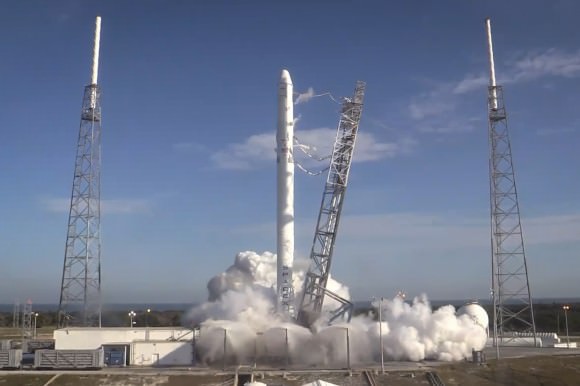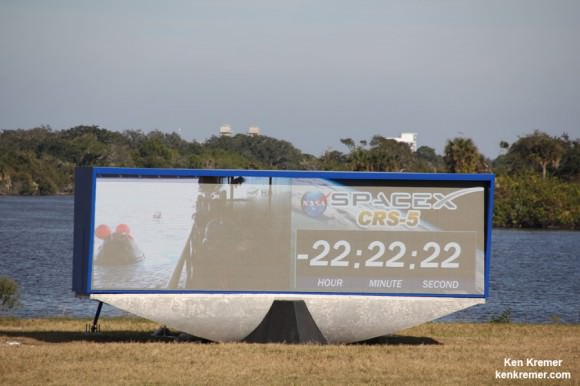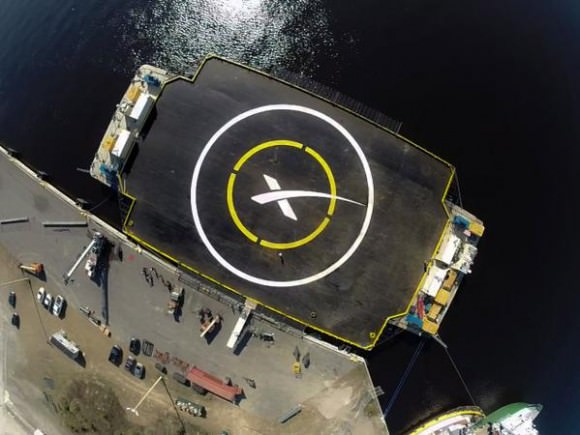KENNEDY SPACE CENTER, FL – To ensure the highest possibility of success for the launch of a critical resupply mission to the International Space Station (ISS), SpaceX has announced the successful completion of a second static fire test of the first stage propulsion system of the firms commercial Falcon 9 rocket on Dec. 19.
The successful engine test clears the path towards a liftoff now rescheduled to early January 2015.
The launch of the Falcon 9 had been slated for Dec. 19, but NASA and SpaceX decided just 1 day before liftoff on Dec. 18 to postpone the launch of the CRS-5 resupply mission into the new year, when the first static fire test failed to run for its full duration of approximately three seconds.
“SpaceX completed a successful static fire test of the Falcon 9 rocket [on Dec. 19] in advance of the CRS-5 mission for NASA,” said SpaceX in a statement.
The second test was done because the first test of the Merlin 1D engines did not run for its full duration of about three seconds.

“While the Dec. 17 static fire test accomplished nearly all of our goals, the test did not run the full duration, ”SpaceX spokesman John Taylor confirmed to Universe Today.
“The data suggests we could push forward without a second attempt, but out of an abundance of caution, we are opting to execute a second static fire test prior to launch.”
Both tests were conducted at Space Launch Complex 40 at Cape Canaveral Air Force Station in Florida.
“We opted to execute a second test,” noted SpaceX.
The SpaceX Falcon 9 rocket carrying the Dragon cargo freighter had been slated to liftoff on Dec. 19 on its next unmanned cargo run dubbed CRS-5 to the ISS under NASA’s Commercial Resupply Services (CRS) contract.

Following the catastrophic failure of the Orbital Sciences Antares rocket and Cygnus cargo freighter on Oct 28 from NASA’s Wallops Flight Facility in Virginia, officials are being prudently cautious to ensure that all measures are being carefully rechecked to maximize the possibilities of a launch success.
The new launch date for CRS-5 is now set for no earlier than Jan. 6, 2015
“Given the extra time needed for data review and testing, coupled with the limited launch date availability due to the holidays and other restrictions, our earliest launch opportunity is now January 6 with January 7 as a backup,” said SpaceX.
The unmanned cargo freighter is loaded with more than 3,700 pounds of scientific experiments, technology demonstrations, crew supplies, spare parts, food, water, clothing and assorted research gear.
The Dragon research experiments will support over 256 science and research investigations for the six person space station crews on Expeditions 42 and 43.
CRS-5 marks the company’s fifth resupply mission to the ISS under a $1.6 Billion contract with NASA to deliver 20,000 kg (44,000 pounds) of cargo to the ISS during a dozen Dragon cargo spacecraft flights through 2016.
Among the other mission goals, SpaceX is planning a daring and bold attempt to propulsively land and recover the first stage on an ocean going platform called the “autonomous spaceport drone ship.”

Watch for Ken’s ongoing SpaceX launch coverage from onsite at the Kennedy Space Center.
Stay tuned here for Ken’s continuing Earth and planetary science and human spaceflight news.


After the booster lands on the drone ship.. How is it secured to the deck? Do nearby deckhands board the drone and do the deeds? or are there robotic cable captures or something? Snag dat rocket! Built in crane to lower the rocket horizontal?
I’ve wondered this too. One thing we can say for sure, though, is that it isn’t deckhands. The drone ship is fully automated. There are no humans on board (for safety reasons. Rockets are dangerous).
From Wiki:
“During rocket landing operations, a separate support ship will be standing by at some designated distance away from the uncrewed drone ship. Following landing, technicians and engineers will reboard the landing platform, and secure the rocket’s landing legs to lock the vehicle in place for transport back to port”
Would love to see some sort of quick acting robotic arm grabby thingy employed on version two to reduce the risk of the 1st stage falling overboard.
gopher65… “…nearby deckhands board the drone…” Meaning, from a nearby recovery vessel.
The obvious answer is that it will quickly be refueled and fly to wherever the next payload is to be picked up. It is a rocket, it flies. If you fly across the Atlantic, the airplane is then not transported back on a ship. It flies back, because it is built to fly. The barge is just a gas station. It will only be difficult in the beginning until they have the entire production chain in place.
It’s not obvious and that’s not the answer. They are landing on a barge as a proof of concept until it can be approved to land on “land”. It’s not going to re-launch from the barge.
Partly true, it is NOT YET going to re-launch from the barge. There will undoubtedly be an intermediate step in this process where it WILL re-launch, not ascend to space, and so descend from a much lower altitude and velocity. This is a logical step that will be required by the approval officials, and will reassure them of the capability and safety of this procedure. Eventually, as you described, it will simply “be approved to land on ‘land’.”
Wow, you’e so quick to speak all the time for someone so incredibly ill-informed.
I would consider the booster landing on the barge a large success. Even if it topples over it is somewhat of a so what issue to me. A first stage that is normally tossed soft lands, falls over, resulting with a lot of large components bent or holed and not recyclable. However:
There are something like thirty thousand very unique parts that are recoverable. These can be tested and if passed find their way right back on to the assembly line. This would still save a lot of money. Best I can figure from downloading draughts of F-9’s this could save about $3.4 million as the parts find their way into new ones.
That is a significant advance. Not perfect, but in this case more than paying for the recovery effort. It still makes Falcon, the cheapest game in town.
Why don’t they land it safely in a huge net then later place it into position I am sure a safety net would work and it could be done at very little cost..
A net is good to capture a flying insect, as every spider knows. But when it comes to a spacecraft at the speed of thousands of meter per second, there’s no net that can stop it. While you read this sentence it travels from the height of an airplane to the ground. Orion instead intends to use parachutes and the ocean as a cushion, and DragonV2 intends to use hot gas pressure from its rocket engines.
You really think that the rocket is going to land on a barge at thousands of meters per second? How, exactly would the rocket survive impact at such at rate of speed? Watch the SpaceX Grasshopper videos if you want to know how it really lands.
There are many ideas around about how to reuse rockets. The Russian Baikal concept proposes to put wings and jet engines on the rocket boosters and land them on a runway:
https://en.wikipedia.org/wiki/Baikal_%28rocket_booster%29
But the simplest and best thing is to just force total control of the movements by rocket power. Like a helicopter does with its rotating wings. Trying to use any systems on the ground, like a net or runway or whatever, would just mess it up and lose all flexibility and economy. It’s a rocket. It can fly and chose where and how to land. Helicopters aren’t shipped around on boats. SpaceX will do this Flash Gordon style.
Actually, Helicopters *are* shipped around on boats. All the time. That’s what helicopter carriers are for. Copters have very short ranges, and can’t fly themselves across large oceans, regardless of what you see in disaster movies.
https://en.wikipedia.org/wiki/Helicopter_carrier
…and again… Kudos!
Even if first slowed down to a descent velocity of near 0 as it enters the (steel?) net, that very net will most likely bend/dent/deform the stage, particularly the attachment of the engines to the stage, due to the weight of the stage. The engineers have decided on the even better option of simply bringing it down on legs, which have been attached in such a way to avoid that kind of damage. Here’s hoping … !
Far Away long Ago do you actually think that a rocket will land at thousands of metres per second ha ha ha your having a laugh mate ha ha ha
Far Away Long Ago wrong again helicopters are transported by Ship as they are too expensive to fly over long distances the same for rockets on earth…